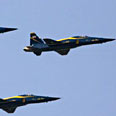Iran's chief of staff, General Atallah Salhi, announced Tuesday that the Iranian air force would be holding a comprehensive military drill during the month of Ramadan, which just began in the Islamic republic.
"In this great exercise we will display a small portion of the abilities and strength of those guarding Iran's skies," the Iranian news agency Fars quoted Salhi as saying.
In a ceremony in honor of the new air force commander, General Hassan Shah Safias, Salhi said that a number of new locally-produced fighter jets will be presented throughout the year.
"The air force has gained achievements in building various fighters, and this year we will present some of these aircraft, which were built by our people." He did not elaborate on the aircraft type.
Outgoing air force chief, General Ahmad Mighani, was recently quoted as saying that Iranian warplanes can now fly 3,000 kilometers (1,865 miles) without refueling. He didn't specify the aircraft type or explain how the range was extended.
Israel is about 1,000 kilometers (620 miles) from Iran. Such a range could be achieved by using external fuel tanks attached to the wings or fuselage that can be released when empty.
Mighani did not refer to Israel by name, but his remarks came after an Israeli air exercise in June that US officials described as a possible rehearsal for a strike on Iran's nuclear facilities.
The Iranians have a habit of boasting about technological achievements in the army and weapons industry, usually in order to deter Western countries from attacking Tehran.
Many times, however, there are discrepancies between local media outlets' reports and the actual capabilities of the discussed weapons and aircraft.
Addressing the possibility that the US and Israel will strike in Iran, the chief of staff said that "today even the countries which are allegedly the United State's friends, understand that it is in fact their enemy, and they too are trying to obtain special air defense systems."
Salhi spoke on the backdrop of fears in the West that Russia will provide Iran with an advance Russian S-300 missile system should the US work to include Georgia and Ukraine in NATO.
















